
Last updated on November 13, 2023 by Krysti
The Philippines is an incredible destination, one that is known for its stunning beaches, endless sunshine, and crystal clear waters. However, the weather here isn’t always as picture-perfect as you’d expect.
Despite its designation as a tropical paradise (which it certainly is!), the Philippines does experience its fair share of unpleasant weather.
But, what exactly does this entail? How many seasons are there in the Philippines? What is the weather in the Philippines actually like? And most importantly, when is the best time to visit the Philippines?
Let’s dive in and discuss all of this and more!
How Many Seasons Are There in the Philippines?
There are officially 2 seasons in the Philippines: the dry season and the rainy season. While the dry season takes place from December to May, the rainy season runs from June to November. That being said, there are some variations within each of these seasons.
The Dry Season in the Philippines
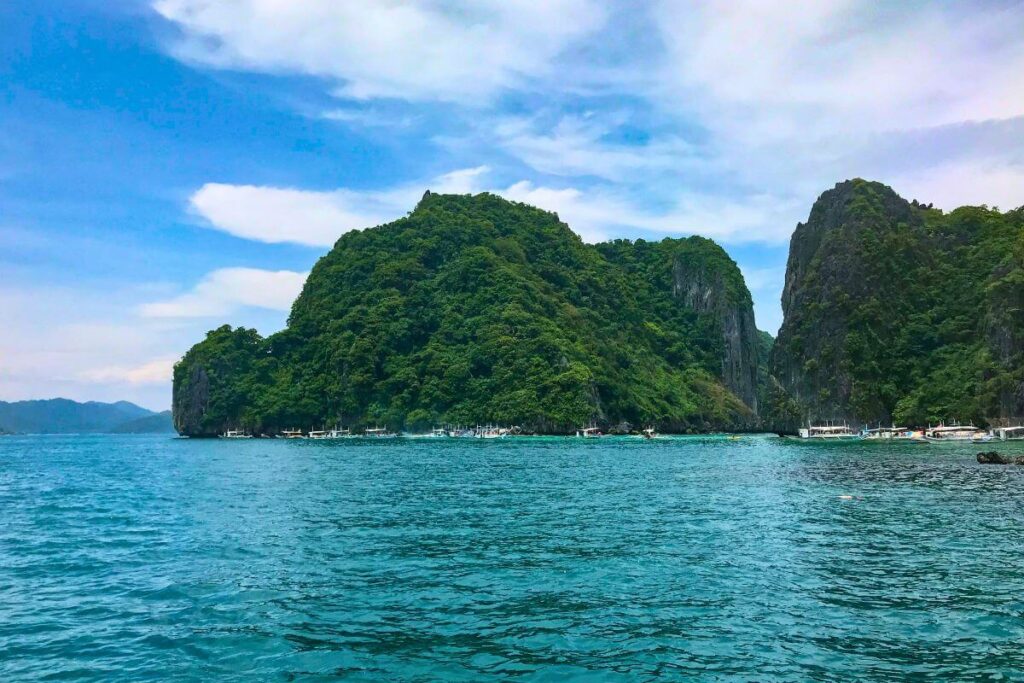
The dry season in the Philippines offers sunny days with blue skies and vibrant waters.
As you may have assumed, the dry season in the Philippines (December – May) typically brings with it dryer weather and more sunshine. Tropical storms are less common, and rainfall occurs at a minimum.
The temperature, however, does fluctuate during this period of time, which has led to the designation of two subcategories: the cool dry season and the hot dry season.
During the cool dry season, which occurs between December and February, the Philippines experiences its coolest temperatures. Average lows during this time can drop down to 70°F or 21°C.
Meanwhile, the hot dry season runs from March to May and brings with it the warmest temperatures of the year. Average highs around this time can reach up to 90°F or 32°C.
The Rainy Season in the Philippines
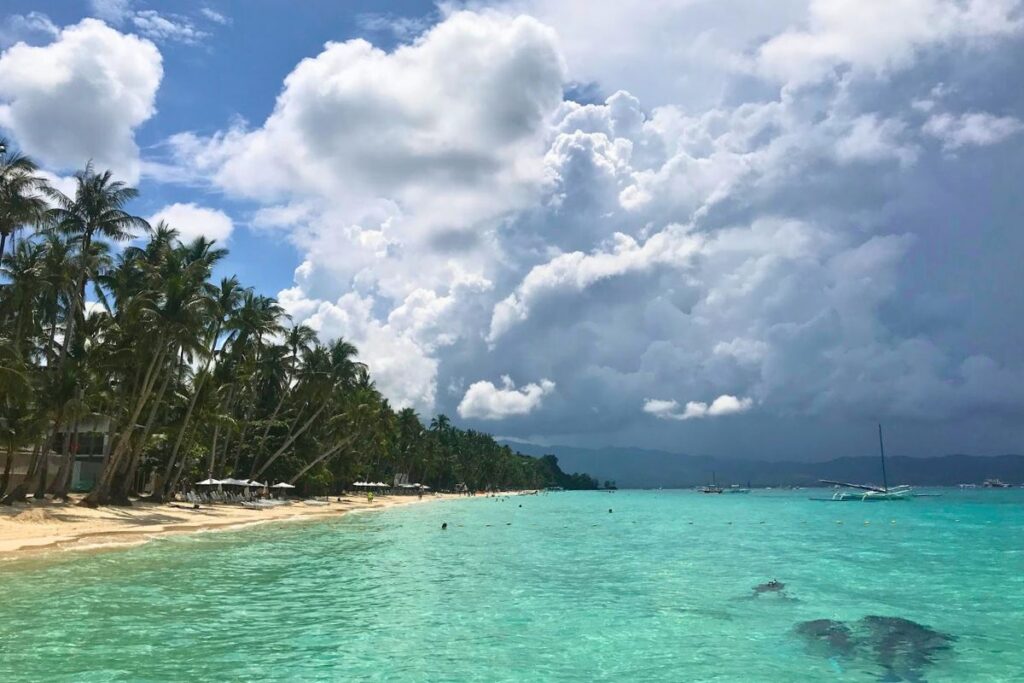
The wet season in the Philippines brings with it a mix of sunshine and tropical storms.
On the other hand, the rainy season in the Philippines (June – November) is known for, you guessed it, rain. Tropical storms and monsoons are frequent during this time of the year and can cause average monthly rainfalls of about 10 to 12 inches.
That being said, this does not mean that it rains every single day. It’s still possible to experience enjoyable weather during the wet season. In fact, the temperatures around this time are quite pleasant, averaging about 79°F or 26°C.
Typhoon Season in the Philippines
Aside from rain, the wet season also brings with it typhoon season. In the Philippines, typhoons, or tropical cyclones, are most active between the months of July and October. However, they are known to occur at any time throughout the rainy season.
These storms can range significantly in strength and size but usually involve heavy periods of rain, strong winds, and flooding. While some cause little to no damage, others have been known to decimate islands and inflict serious harm.
The Philippine Atmospheric, Geophysical and Astronomical Services Administration is responsible for tracking these storms and issuing tropical cyclone warnings as needed. If you do plan to visit the Philippines during this time of the year, it’s important to remain aware of any alerts they may issue, as these storms can pop up pretty quickly.
Weather in the Philippines By Month
Let’s break this all down a bit further and take a look at the seasons in the Philippines month-by-month.
**Just a quick note: Specific temperatures and travel conditions can vary from island to island, but this brief overview should give you a good idea of what to expect each month.
The Philippines in January
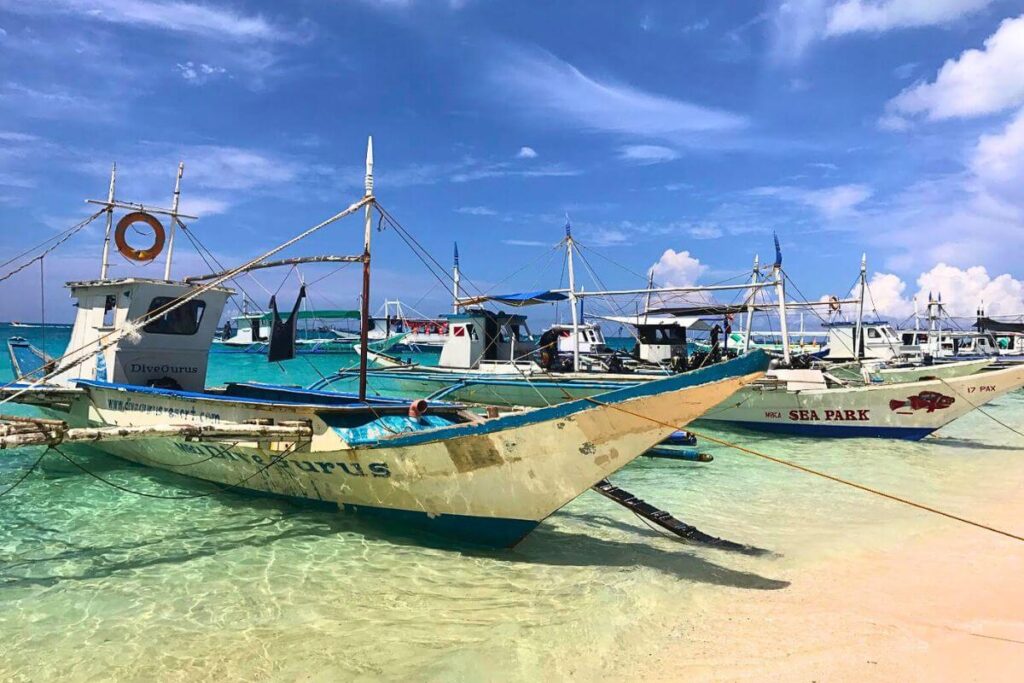
January is a great time to go island hopping in the Philippines.
January is a great time to visit the Philippines as it offers excellent weather. Rain during this month is minimal, and temperatures are pleasant, averaging around 77°F or 25°C.
Given that the weather is so nice, January also happens to be peak season for travel in the Philippines. As such, you can expect more crowds and higher prices. New Year’s Eve, in particular, is quite busy and expensive compared to the rest of the year.
The Philippines in February
The month of February experiences weather that’s very similar to January. Again, rain is minimal, and average temperatures fall around 77°F or 25°C.
While still a busy time for travel, the Philippine Islands usually aren’t as crowded in February because the holiday rush has subsided. Despite this, you may still encounter higher-than-expected prices for accommodations and activities.
The Philippines in March
March continues to offer pleasant weather with little rain. However, temperatures in the Philippines do start to rise a bit, averaging around 79°F or 26°C.
Meanwhile, travel is still at a peak, as many people venture out to the islands during spring break. You can expect to encounter more crowds, especially around beach towns and resorts.
In addition to this, you may see an increase in domestic travel, depending upon the date that Easter falls upon. Holy Week is a major holiday in the Philippines, so lots of locals travel during this time. As such, hotels fill up quickly, businesses close down, and prices skyrocket. If you can avoid traveling at all during this holiday, I highly recommend it.
The Philippines in April
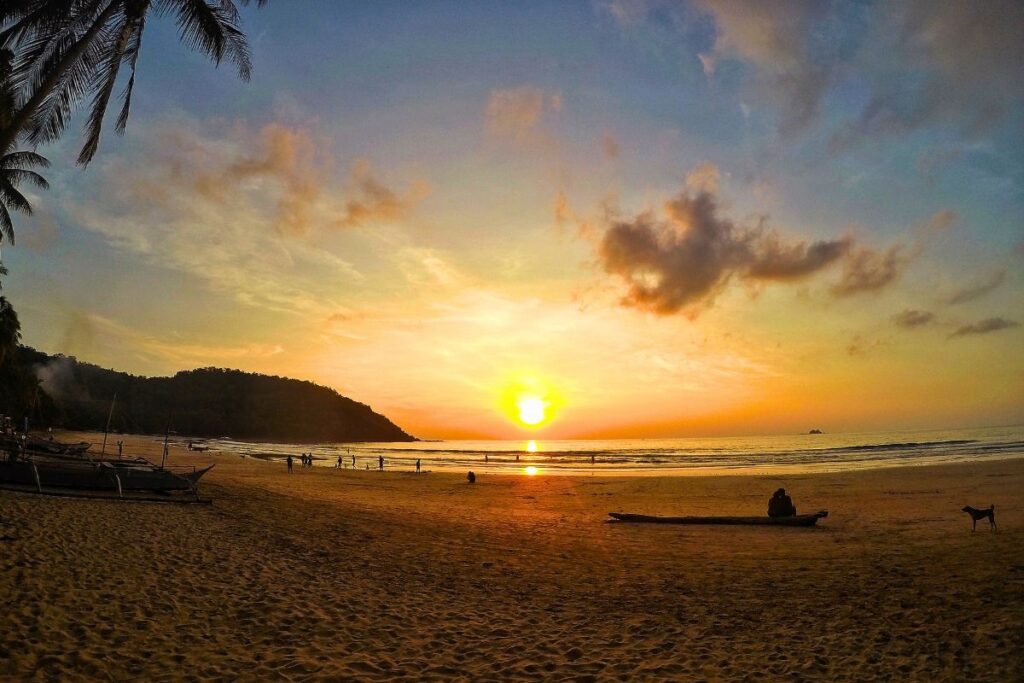
The dry season in the Philippines offers incredible sunsets.
Temperatures continue to rise in the Philippines during the month of April, with averages falling around 81°F or 27°C. Rain is still minimal, allowing for lots of sunshine and clear skies.
That being said, April is the last month for peak travel. So you should continue to expect busy crowds and higher prices.
Similar to March, depending upon the date of Easter, local travel may increase for Holy Week. Again, if you can avoid traveling during this time, it’s highly advisable to do so, as prices are known to increase and hotels can fill up quickly.
The Philippines in May
May is the hottest month in the Philippines, so you expect lots of heat and humidity. Average temperatures around this time usually fall close to 82°F or 28°C, with minimal rain for the most part.
That being said, the country does begin its transition into the rainy season during this time. So you may start to see some scattered storms pop up, at the end of the month.
In terms of travel, May is part of the shoulder season and, as such, is considered by many to be a great time to visit the Philippines. Throughout the month, you can expect to encounter significantly fewer crowds and lower prices.
The Philippines in June
In June, the rainy season really starts to take off, especially in the northern part of the country. Average rainfall during this month hovers around 10 inches. Meanwhile, temperatures begin to cool down a bit, dropping to 80°F or 26.5°C.
Travel during this time of year tends to slow down as well, given the rainy weather. However, it is still possible to visit the Philippines in June and find a few dry spots. Central and southern destinations, in particular Cebu, are known to remain relatively dry for most of the month.
The Philippines in July
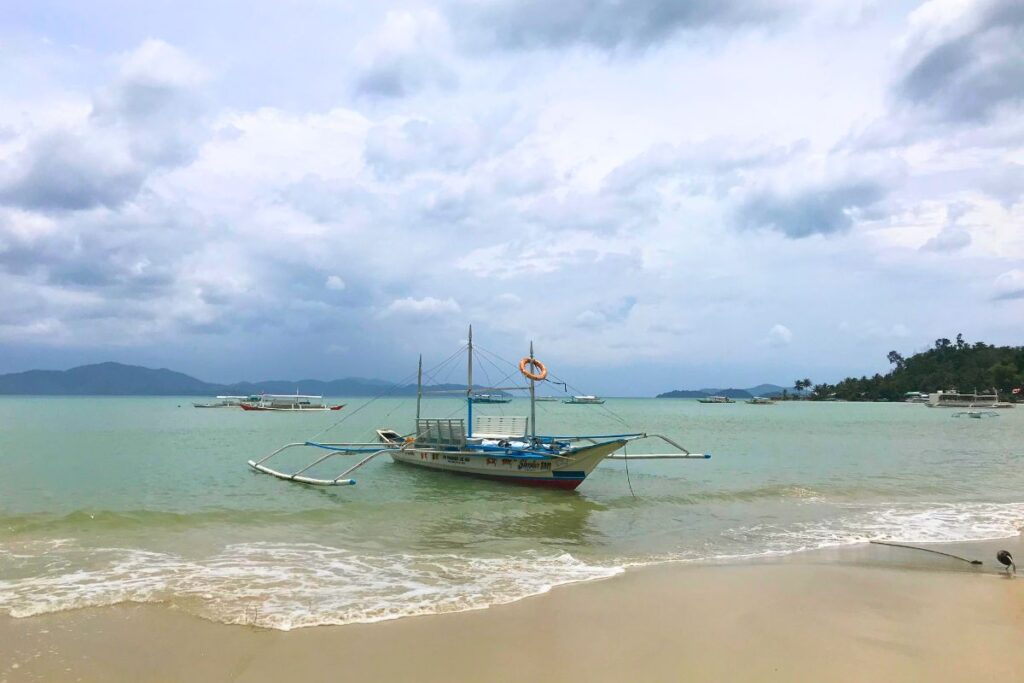
Cloudy days are common during the rainy season in the Philippines.
July brings with it more rain, averaging about 11 inches throughout the month. At the same time, temperatures continue to drop, hovering around an average of 79°F or 26°C.
As one of the rainiest months in the Philippines, July is definitely the low season for travel. However, similar to June, it’s still possible to find some relatively dry destinations, such as Cebu and Samar.
The Philippines in August
August is not only the rainiest month in the Philippines, it’s also when you’re most likely to encounter a typhoon. Average rainfall during this month hovers near 12 inches, while temperatures remain around 79°F or 26°C.
Given the potential for storms, not many tourists venture out to the Philippines in August, although it is possible to do so. If you opt to travel during this time, it’s important to remain aware of any alerts that may arise.
The Philippines in September
Similar to August, September brings lots of rain and the potential for typhoons. The monthly rainfall averages around 11 inches, and temperatures hover near 79°F or 26°C.
Again, if you opt to travel to the Philippines during this time, it’s important to remain aware and up-to-date of any potential typhoons and tropical cyclones that may develop.
The Philippines in October
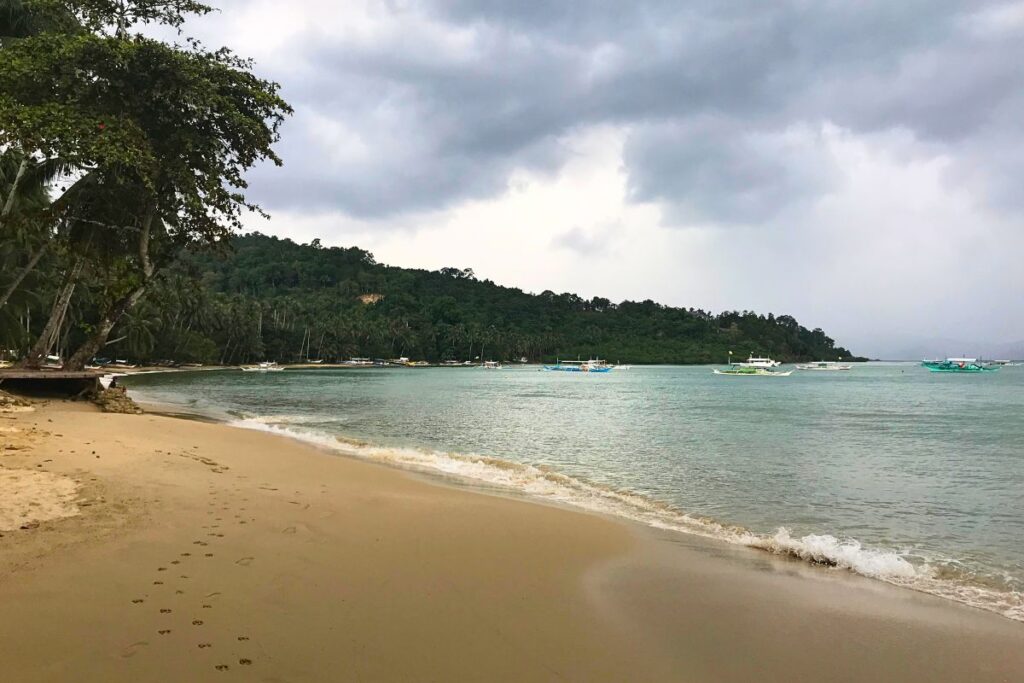
The beach can still be fun to visit during the rainy season in the Philippines.
October sees the end of peak typhoon season in the Philippines. While rain is still common, averaging about 11 inches, tropical storms tend to taper off by the end of the month. Meanwhile, temperatures remain consistent, averaging about 79°F or 26°C.
Travel in October becomes a bit safer, but it’s still important to remain alert, as storms can develop at any time during the rainy season.
The Philippines in November
With November comes the end of the wet season in the Philippines. While you’re still likely to encounter rain at the beginning of the month, the dry season usually takes over by the end of it. Meanwhile, temperatures during this time start to drop slightly, averaging around 78°F or 25.5°C.
Considered to be part of the shoulder season, November (especially the end of November) is a great time to visit the Philippines. You can expect mostly nice weather, fewer crowds, and more affordable prices.
The Philippines in December
December marks the official start of the dry season in the Philippines. While rain is still possible, it’s significantly less likely. Temperatures,, meanwhile, continue to remain on the cooler end, averaging around 78°F or 25.5°C.
During this time, travel does begin to peak again as visitors take advantage of the holidays. You can expect to see an increase in crowds and prices throughout the month – especially in the days leading up to Christmas.
The Best Time to Visit the Philippines
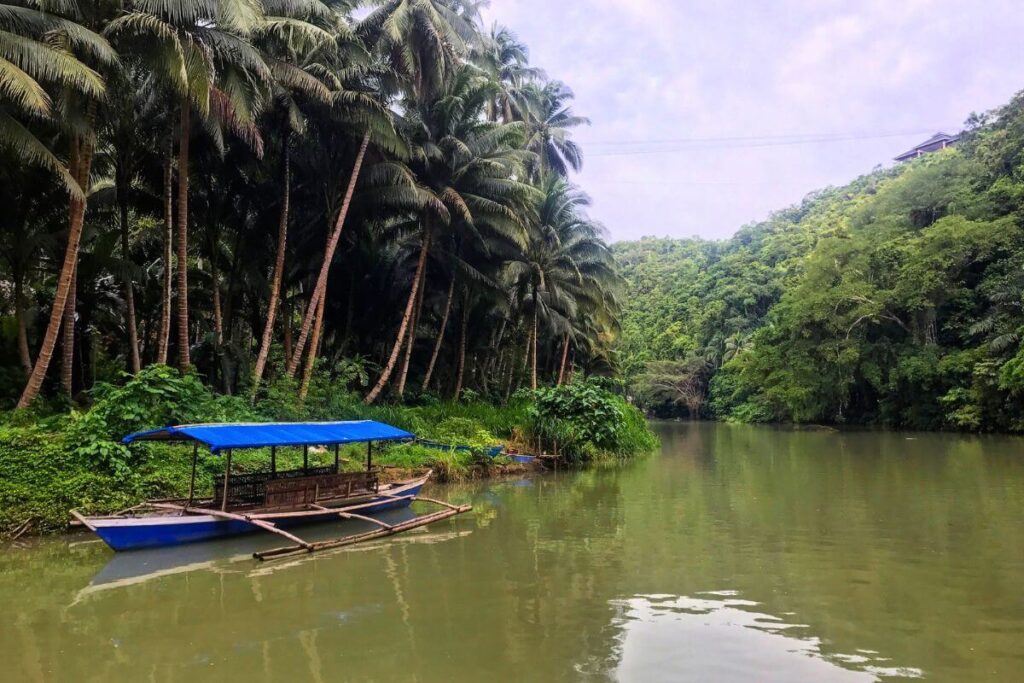
Which of the seasons in the Philippines is best? Without a doubt, the dry season!
So when is the best time to plan your Philippines itinerary?
The general consensus is the dry season (from December to May). The period of time is considered to be the best time to visit the Philippines.
However, is also coincides with peak travel season, which means you’re likely to encounter more crowds and higher prices.
Specifically, December and January are known to be very crowded around the holidays and the New Year. Likewise, March is pretty busy as it coincides with spring break. And finally, March and April can both experience high levels of domestic travel, depending upon the date of Easter. Holy Week is a major holiday in the Philippines, so hotels fill up quickly, businesses close down, and prices have been known to skyrocket.
If you wish to avoid all of this, I highly recommend traveling during the shoulder season in the months of May and November. Around this time, the weather is still nice, there are fewer crowds, and prices are usually a bit more affordable.
The month of May does bring with it higher temperatures, so if you prefer milder weather, shoot for the end of November. Alternatively, if you don’t mind or even enjoy the heat, then May is the perfect time to go.
Traveling During the Rainy Season in the Philippines
If, for whatever reason, you can’t line your schedule up and end up traveling to the Philippines during the rainy season, don’t stress too much. It doesn’t mean you won’t have an enjoyable time; it just means you may need to be more flexible with your schedule.
I’ve personally visited the Philippines twice during the rainy season and still had a great time. I traveled to several destinations, including Boracay and Palawan, and had a lot of fun, even when it did rain.
So don’t let the possibility of rain hold you back – Go for it! Just plan accordingly and be flexible!
7 Incredible Places to Visit During the Rainy Season in the Philippines
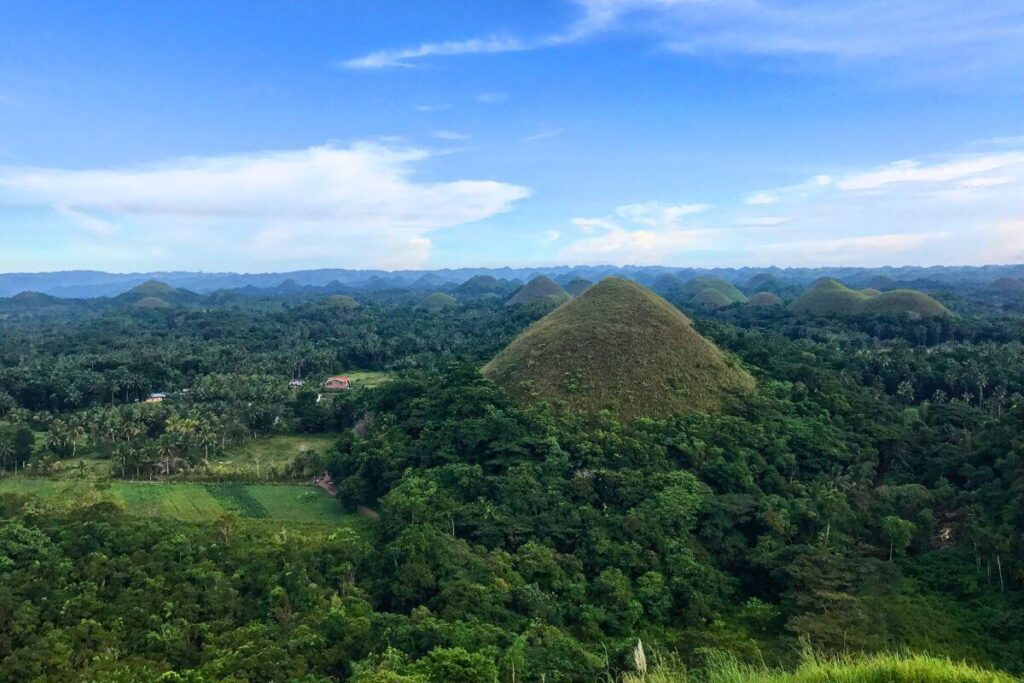
Bohol becomes even more beautiful during the rainy season when the island is blanketed in vibrant shades of green.
Believe it or not, there are quite a few places in the Philippines that are just as fun, if not more fun, during the rainy season.
- Siargao – As the surfing capital of the Philippines, Siargao offers great waves year-round. However, some of the best waves can be found during the rainy season when storms bring in stronger swells.
- Boracay – A popular beach destination, Boracay is known for its watersports. While these can be enjoyed any time of the year, windsurfing and kiteboarding are particularly fun during the rainy season when the winds pick up.
- Cebu – Generally speaking, Cebu experiences less rain than other parts of the Philippines. But even when it does get hit with bad weather, it’s still a great place to visit. The island is home to several cascading waterfalls that become even more beautiful during the rainy season.
- Camiguin – A volcanic island, Camiguin is home to several hot springs, many of which are enjoyable even on the rainiest of days. The island also offers a number of beautiful waterfalls that flow freely during the rainy season.
- Palawan – Given its location, Palawan is less likely to experience typhoons and tropical storms. As such, it’s considered to be a safer destination during the rainy season. But even when it does rain, there’s still plenty to do; in fact, scuba diving is a popular rainy-day activity here, as underwater visibility generally remains great regardless of the weather.
- Bohol – Known for its incredible landscapes, Bohol becomes even more beautiful during the rainy season when everything turns a vibrant shade of green. This is especially true for the island’s most famous attraction, the Chocolate Hills.
- Manila – As the capital of the Philippines, Manila is home to a wide variety of shops, museums, resorts, and attractions that can be enjoyed even during the rainy season. Some of the city’s most popular indoor tourist spots include the National Museum of the Philippines, Manila Ocean Park, SM Mall of Asia, and the Manila Cathedral.
Frequently Asked Questions About Seasons in the Philippines

This photo was taken on a trip to Bohol during the rainy season.
Here are my thoughts on some commonly asked questions about the weather and climate in the Philippines.
Why Are There Only Two Seasons in the Philippines?
The Philippines lies close to the equator, within the tropical zone. This means that the country receives the same amount of daylight throughout the year, which, in turn, prevents it from experiencing any significant temperature changes. As such, the Philippines’ weather seasons are not determined by daylight or temperature. Instead, they are determined by the amount of rainfall received. Given the variations in seasonal winds, weather in the Philippines can be divided into two main seasons: the dry season and the rainy season.
When Is Typhoon Season in the Philippines?
In the Philippines, typhoon season occurs during the rainy season between the months of June and November. However, peak typhoon season typically takes place between July and October. According to the Philippine Atmospheric, Geophysical and Astronomical Services Administration, this is when approximately 70% of typhoons in the region develop. The Philippines typically gets hit with an average of 8 or 9 typhoons a year.
What Is the Coldest Month in the Philippines?
The coldest month in the Philippines is January, when the mean temperature is about 77°F or 25°C. However, temperatures have been known to drop to an average low of 70°F or 21°C. Of course, this will vary depending on where you are in the country. For example, Baguio City in Northern Luzon can see temperatures drop down to 66°F or 19°C in the evenings.
What Is the Hottest Month in the Philippines?
The hottest month in the Philippines is May, when the mean temperature is about 82°F or 28°C. However, temperatures have been known to reach an average high of 90°F or 32°C. That being said, when you factor in humidity, it can feel even warmer than this. While not common, some cities have experienced heat indexes as high as 122°F or 50°C in the month of May.
Final Thoughts: Seasons in the Philippines
Regardless of when you visit the Philippines, you’re sure to have an amazing time! Whether it’s the dry season or the rainy season, there’s certainly plenty to do and see.
However, if you have the flexibility to go at any time, I highly recommend the shoulder season in May or November. During this time of the year, the weather’s enjoyable, the crowds aren’t too bad, and the prices are affordable – it’s the perfect trifecta!
Have you been to the Philippine Islands? Is there anything you’d like to share about the weather or the seasons in the Philippines? Let me know in the comments below!
Like this post about the Philippines’ climate? Pin it now for later!





